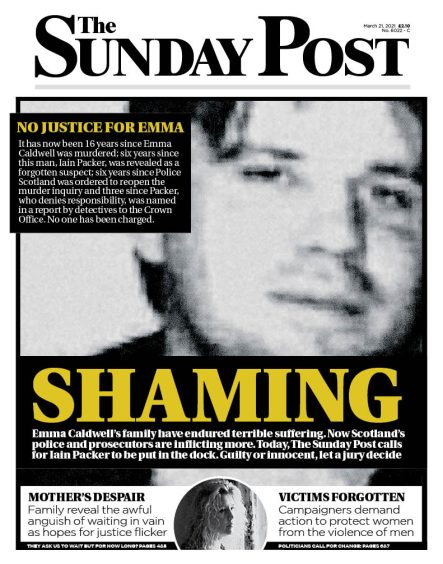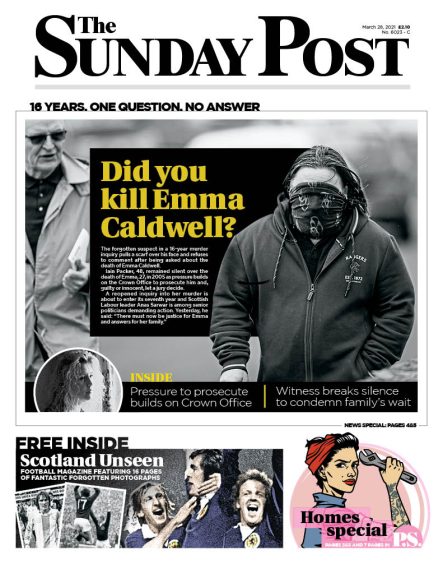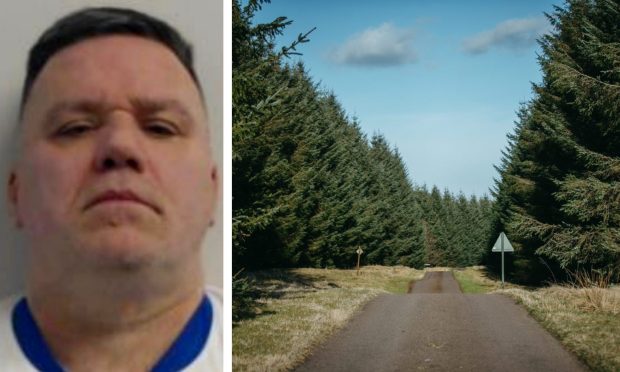
Scotland’s most senior prosecutors have known for 17 years that Iain Packer directed police to the isolated forestry track where Emma Caldwell was murdered, we can reveal.
The Crown Office was given details of all six police interviews with Packer on September 20 2007, according to an official report, just months before dropping murder charges against four other men.
The revelation increases pressure on prosecutors to explain why it took almost two decades to put a prime suspect into the dock.
Packer was last week sentenced to a minimum of 36 years for Emma’s murder.
The shop-sign fitter was interviewed six times by detectives during the murder inquiry before finally admitting knowing Emma and directing officers to the forestry track 40 miles south of Glasgow where her body had been found in May 2005. He was never spoken to again, however, as a covert surveillance operation wrongly focused on four Turkish suspects.
Crown Office told about Iain Packer in 2007
The failure of Police Scotland to secure justice sooner has been widely questioned and we can reveal today the Crown Office was told about Packer in September 2007. In 2017 it was revealed officers had given all Packer’s interviews to prosecutors in 2007 – just two months before the Turks were freed after being held for 80 days awaiting trial.
When that case collapsed, police and prosecutors did nothing to pursue Packer until he was exposed in the media almost eight years later. Gerry Gallacher, the former detective turned author who uncovered Packer while researching the investigation, yesterday said the Crown Office as well as Police Scotland must now be compelled to explain their actions.
He said the failure to prosecute Packer for almost two decades, despite compelling evidence against him, demands urgent independent investigation. He said: “On the evidence collected in the months after Emma died, this man could have been arrested, charged, prosecuted and convicted. It is almost 19 years since Emma died, 16 since the case against the Turks collapsed and nine since the murder investigation was re-opened, yet virtually no new evidence was needed to convict him.
“That remains shocking to me, almost unbelievable. But for Emma’s family it must feel like an absolute betrayal. Our justice system, police and prosecutors, must be asked to justify their actions and inaction.”
Packer’s interviews
Packer was first interviewed within weeks of Emma’s body being discovered. Emma’s drug addiction forced her to work in Glasgow’s red-light zone. There, after her death, other sex workers said Packer, a habitual user of prostitutes with a history of violence, was obsessed with her.
Detectives spoke to him first in June 2005, twice more the following month, then in August and October 2006 and finally in March the following year. By then Packer had changed his story repeatedly, from saying he had not known Emma to admitting driving her out of the city for sex.
During his sixth and final interview, in 2007, he directed detectives on the 45-minute, 40-mile drive to the secluded forestry track near Roberton, South Lanarkshire, where he admitted taking Emma and where her body was found. She had been strangled. The detectives expected him to confess but, after returning to Cathcart police station in Glasgow’s southside and asking for guidance from senior officers, were told to let him go and not speak to him again.
The officers in charge of the investigation were focused on other suspects linked to a Turkish cafe in Glasgow where men were known to take sex workers.
The Turks had become suspects in the first weeks of the inquiry. A 76-second call to Emma’s phone on the night she disappeared was made by one of the men.
Emma’s phone had last “pinged” close to a Turkish cafe said to be a drinking and gambling den where men took prostitutes. Some were raped, it was alleged, and a drop of blood on a quilt revealed Emma’s DNA.
The inquiry had cost an estimated £4 million by the time it collapsed when four Turks were released after translators commissioned by their lawyers said taped conversations allegedly containing admissions of their guilt were, in fact, innocuous.
Meanwhile, a soil sample taken from Packer’s van in 2005 was not sent for analysis until 2022. An expert told the trial it most likely came from the woods where Emma’s body was found.
Detectives promoted
Many detectives involved in the original investigation would go on to be promoted in the following years.
Ruaridh Nicolson, later promoted to deputy chief constable at Police Scotland, was in charge of Strathclyde CID at the time of the murder. Willie Johnston led the initial inquiry. When he retired John Mitchell took over. He became head of CID and, after retiring, became Director of Investigations for the Police Investigation and Review Commission.
Detectives John Cuddihy and Colin Field took charge of the surveillance targeting the Turkish cafe.
Gallacher, who retired from the police in 2010 after 30 years, said: “There were reasons why the police convinced themselves of the Turks guilt but none were as compelling as the reasons that made Packer a prime suspect. It was hugely embarrassing for police and prosecutors when all the evidence proved worthless.
“However, professional embarrassment is no excuse for allowing a suspected killer to go free and betraying the family of his victim and all the other victims he would go on to assault and terrorise.”
The Crown Office and Procurator Fiscal Service said: “This week the Lord Advocate will meet with Emma’s family and their solicitor to answer questions about the investigation and criminal proceedings.
“It would not be appropriate to comment publicly on matters that should be discussed first with Emma’s family. However, we can confirm a previous statement that, following a full independent investigation, Crown Counsel concluded there was insufficient evidence of criminality on the part of any police officer involved in the investigation of Emma Caldwell’s murder. The Crown reserved the right to proceed in the future should further evidence become available.”
Post confronts cowardly killer
Iain Packer was not in the mood for talking when approached by The Sunday Post almost a year before his arrest for Emma Caldwell’s murder.
We had gone to his home in the south-east area of Glasgow in March 2021 to ask him about the crime.
He declined to come to the door but dressed in a hoodie and jeans, he later emerged for a short walk.
His movements were slow and he was using a walking stick.
When Packer spotted our reporter Russell Blackstock in the street, along with our photographer, he swiftly pulled a scarf up over his face. He didn’t speak a word when he was asked if he had killed Emma Caldwell.
Before heading back into his house, he also maintained his silence when further asked if he felt that the police should now either charge him with a crime in connection with the case, or officially discount him from their investigations.
Campaign for justice
March 21 2021
As the reopened inquiry into the murder of Emma Caldwell drags towards a seventh year, we brand the wait for justice “shaming,” on our front page, adding: “Emma Caldwell’s family has endured terrible suffering. Now Scotland’s police and prosecutors are inflicting more. Today, The Sunday Post calls for Iain Packer to be put in the dock. Guilty or innocent, let a jury decide.”
March 28 2021
We confront Iain Packer outside his parents’ home in the east of Glasgow but the prime suspect in the 16-year-old murder inquiry pulls a scarf over his face and says nothing as reporter Russell Blackstock asks the only question that matters: “Did you kill Emma Caldwell?” Scottish Labour leader Anas Sarwar backs the escalating calls to let a jury decide Packer’s guilt or innocence.
April 4 2021
A coruscating letter from Aamer Anwar, the lawyer for Emma Caldwell’s family, to Lord Advocate James Wolffe says their treatment is “cynical and cruel”. He tells Wolffe: “If you do not have the courage to fulfil promises perhaps the time has come for you to consider your position. There’s no reasonable explanation why it has taken six years to decide whether to indict the alleged killer.”
‘I told police about Packer. They didn’t react’
A woman who dedicated her life to getting girls off the streets has revealed she repeatedly told police about Packer preying on Emma.
But Anne McIlveen, who ran the Salt & Light refuge bus that would shelter vulnerable girls, said: “The police weren’t interested.
“All they could talk about were the Turkish men they were obsessed about.
“I told them repeatedly that they were looking at the wrong people, it was Packer the girls were terrified of, not the Turks.”
Emma Caldwell: Police condemned for launching a molehunt instead of a manhunt
Anne, 65, who was awarded the MBE for her work, told police that Packer would come to the bus and shout for Emma.
And she claims after Emma was found murdered, Packer returned to the bus looking for other girls.
She said: “We’d see him off and he was angry that we interfered. But I did not care. I just wanted to protect Emma from him.
“The bus was a refuge for the girls, somewhere they could just relax, get something to eat or get support. Whatever they needed.
“When the police interviewed me, I told them everything I knew about Packer, including how he kept looking for Emma.
“I told them as soon as Emma disappeared, he never came back looking for her again.
“They just noted everything down. They didn’t react.”

Enjoy the convenience of having The Sunday Post delivered as a digital ePaper straight to your smartphone, tablet or computer.
Subscribe for only £5.49 a month and enjoy all the benefits of the printed paper as a digital replica.
Subscribe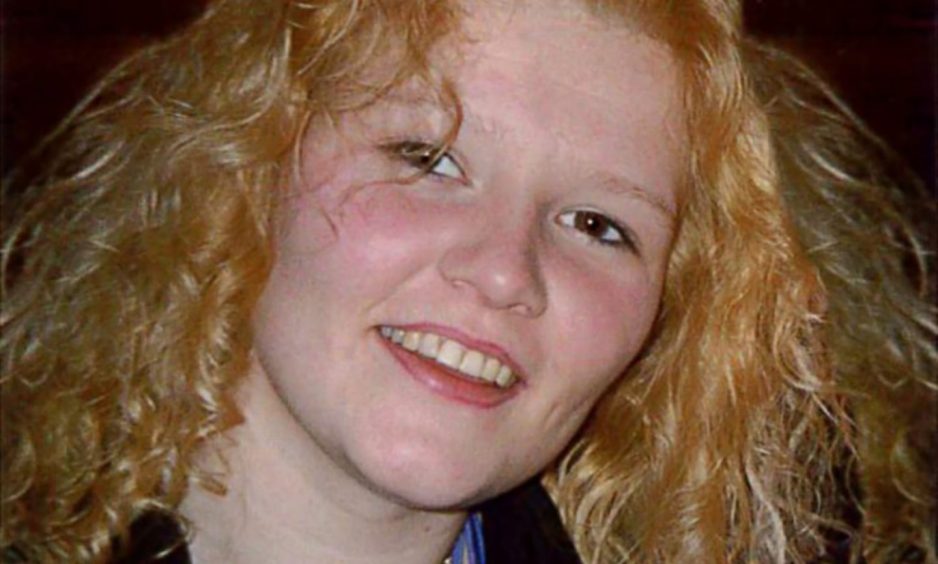
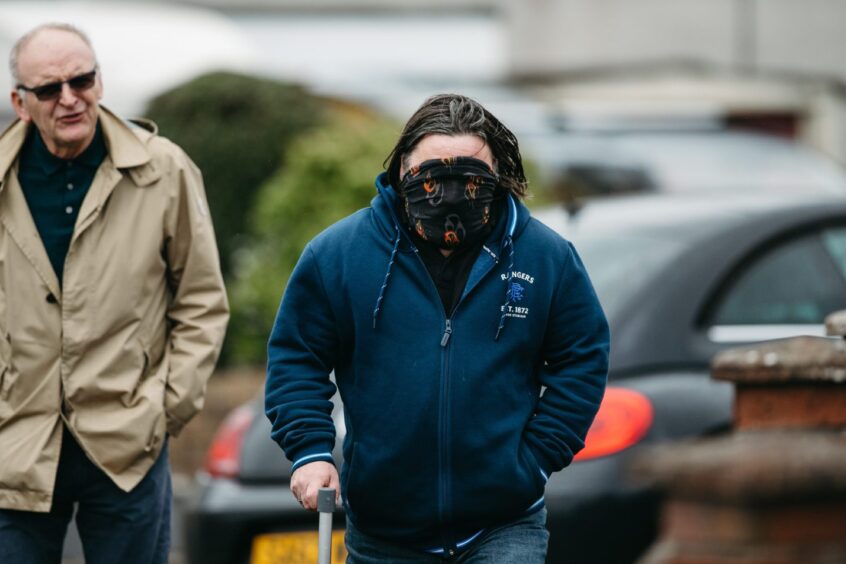 © Andrew Cawley
© Andrew Cawley